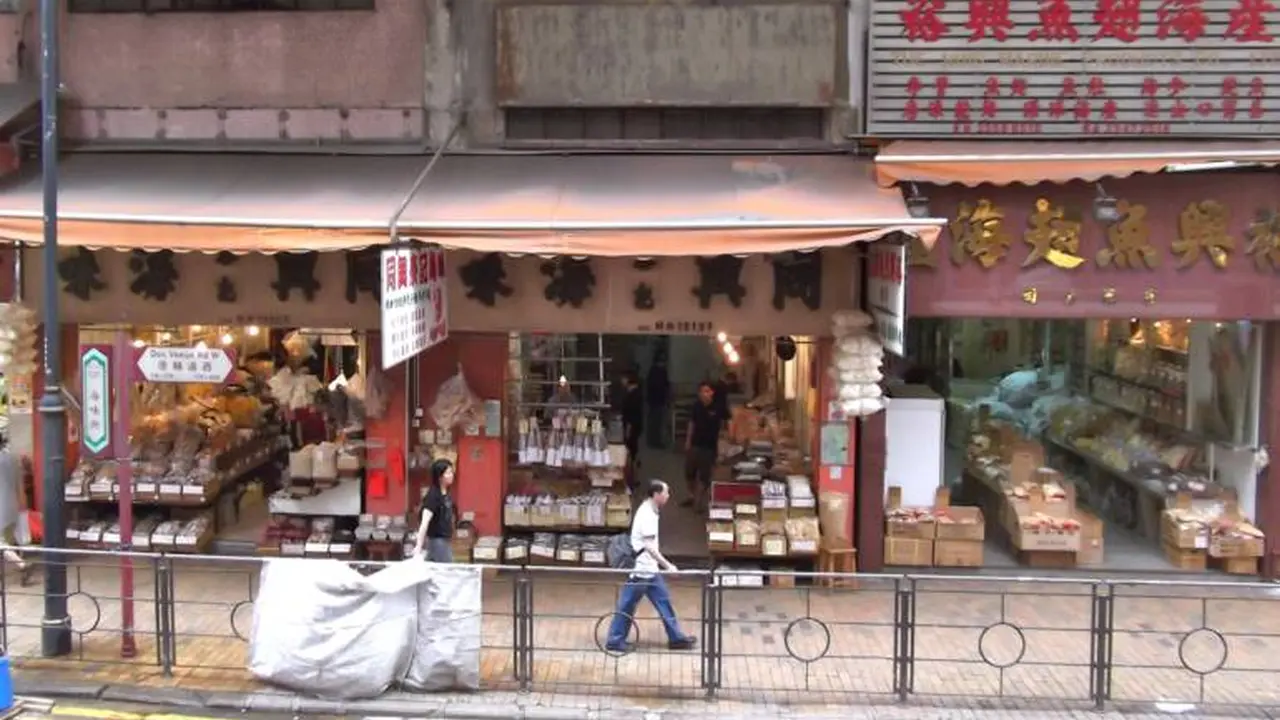Hong Kong's Best Dried Seafood Street: Culinary Delights

Unveiling the Treasures of Dried Seafood Street in Hong Kong
Alright folks, buckle up because we're diving deep into one of Hong Kong's most unique and flavorful destinations: Dried Seafood Street! Officially known as Des Voeux Road West in Sheung Wan, this ain't your average shopping district. Forget the high-end boutiques; we're talking rows and rows of shops overflowing with dried scallops, abalone, mushrooms, sea cucumbers, and enough other marine goodies to make Neptune jealous. It's a sensory overload in the best possible way – the pungent aromas, the vibrant colors, the sheer variety... it's an experience you won't soon forget.
But why dried seafood? Well, drying food has been a preservation method for centuries, and in Hong Kong, it's become a culinary art form. These dried ingredients aren't just about extending shelf life; they concentrate the flavors, creating intensely savory and umami-rich additions to soups, stews, and stir-fries. Think of it as seafood supercharged!
Navigating Dried Seafood Street A First-Timer's Guide
Okay, so you're standing on Des Voeux Road West, surrounded by mountains of dried seafood. Where do you even begin? Don't panic! Here's a survival guide to help you navigate this fascinating market:
- Embrace the Chaos: This place is busy, bustling, and often crowded. Just go with the flow and enjoy the energy.
- Haggle (Politely): Prices are often negotiable, especially if you're buying in bulk. A friendly smile and a bit of bargaining can go a long way.
- Ask Questions: Don't be afraid to ask shopkeepers about their products. They're usually happy to share their knowledge and recommendations.
- Carry Cash: While some shops may accept credit cards, cash is still king on Dried Seafood Street.
- Be Prepared for Strong Smells: The aroma of dried seafood can be quite potent, especially on a hot day. If you're sensitive to strong smells, you might want to bring a mask or take breaks outside.
Must-Try Dried Seafood Products and Their Uses
Now for the fun part: the shopping! Here are a few of the most popular (and delicious) dried seafood products you'll find on Dried Seafood Street, along with some ideas on how to use them:
Dried Scallops (Conpoy) The Umami Bomb
Dried scallops, or conpoy, are a staple in Cantonese cuisine. These little guys are packed with umami flavor and are used to add depth and richness to soups, congee, and stir-fries.
- Usage: Soak dried scallops in warm water for at least 30 minutes (or longer for larger scallops) to rehydrate them. Shred them and add them to soups, congee, or stir-fries. You can also use the soaking liquid to add extra flavor to your dishes.
- Product Recommendation: Look for scallops that are plump, firm, and have a slightly sweet aroma. Avoid scallops that are overly dry or have a fishy smell. A good mid-range option might be around HKD 300-500 per catty (approximately 600 grams).
- Comparison: Smaller, less expensive scallops are fine for adding flavor to soups, while larger, more expensive scallops are better for eating on their own or as a garnish. The size and origin (Japanese scallops are generally considered superior) significantly impact the price.
- Scenario: Adding a handful of shredded dried scallops to a simple chicken congee elevates it to a comforting and flavorful meal, perfect for a chilly evening.
Dried Abalone The Luxurious Delicacy
Dried abalone is considered a luxurious ingredient in Chinese cuisine. It's known for its chewy texture and delicate, slightly sweet flavor. It's often served at banquets and special occasions.
- Usage: Dried abalone requires a long and slow cooking process to tenderize it. It's typically soaked for several days, then simmered for hours until it's soft and pliable. It's often braised with other ingredients like shiitake mushrooms and vegetables.
- Product Recommendation: The price of dried abalone can vary dramatically depending on its size, origin, and quality. South African abalone tends to be more affordable, while Japanese abalone is highly prized and can cost thousands of Hong Kong dollars per piece. For a decent quality South African abalone, expect to pay around HKD 800-1500 per catty.
- Comparison: Smaller, less expensive abalone can be used in soups and stews, while larger, more expensive abalone is typically served whole as a centerpiece dish. Consider the size and the occasion when choosing your abalone.
- Scenario: Braised abalone with shiitake mushrooms and bok choy is a classic Chinese dish that's often served at weddings and other celebrations.
Dried Sea Cucumber The Collagen Powerhouse
Dried sea cucumber is another prized ingredient in Chinese cuisine, known for its unique texture and nutritional benefits. It's rich in collagen and is believed to have health-boosting properties.
- Usage: Like dried abalone, dried sea cucumber requires a long soaking and cooking process to soften it. It's typically soaked for several days, then simmered until it's tender. It's often braised with other ingredients or added to soups.
- Product Recommendation: Sea cucumber comes in various grades, with the prickly sea cucumber being considered higher quality. Prices can range from HKD 500 to several thousand per catty depending on the type and size. A good starting point would be a mid-range prickly sea cucumber for around HKD 1000-2000 per catty.
- Comparison: Different types of sea cucumber have different textures and flavors. Some are chewier, while others are more delicate. Consider your personal preference when choosing your sea cucumber.
- Scenario: Sea cucumber soup is a popular dish in Hong Kong, often served during the winter months to nourish the body and warm the soul.
Dried Shiitake Mushrooms The Earthy Delight
While technically not seafood, dried shiitake mushrooms are a common sight on Dried Seafood Street and are a must-have ingredient in many Chinese dishes. They have a rich, earthy flavor that adds depth and complexity to soups, stews, and stir-fries.
- Usage: Soak dried shiitake mushrooms in warm water for at least 30 minutes to rehydrate them. Squeeze out the excess water and discard the stems (they can be tough). Slice or dice the mushrooms and add them to your dishes.
- Product Recommendation: Look for mushrooms that are thick, firm, and have a dark brown color. Avoid mushrooms that are brittle or have a musty smell. Japanese shiitake mushrooms are generally considered superior and more expensive, costing around HKD 200-400 per catty. Chinese shiitake mushrooms are a more affordable option, around HKD 100-200 per catty.
- Comparison: The thickness and cap size of the shiitake mushroom affects its texture and flavor. Thicker caps are more flavorful and hold their shape better during cooking.
- Scenario: Adding dried shiitake mushrooms to a simple stir-fry with vegetables and tofu instantly elevates it with a rich, umami flavor.
Dried Shrimp (Har Mai) The Salty Enhancer
Dried shrimp, known as "har mai" in Cantonese, are small, intensely flavored shrimp that have been dried and salted. They are used to add a salty and umami flavor to a variety of dishes.
- Usage: Rinse the dried shrimp briefly under cold water to remove any excess salt. They can be added directly to stir-fries, soups, or congee, or ground into a powder and used as a seasoning.
- Product Recommendation: Look for dried shrimp that are plump, firm, and have a vibrant pink or orange color. Avoid shrimp that are overly dry or have a fishy smell. Prices typically range from HKD 80-200 per catty depending on the size and quality.
- Comparison: Smaller dried shrimp are ideal for adding a subtle flavor to soups and congee, while larger dried shrimp can be used as a main ingredient in stir-fries.
- Scenario: Adding a handful of dried shrimp to a vegetable stir-fry adds a salty and savory element that complements the sweetness of the vegetables.
Beyond the Big Names Other Dried Delights to Discover
While the above are some of the most common dried seafood products, Dried Seafood Street is also home to a treasure trove of other interesting ingredients. Keep an eye out for:
- Dried Oysters (Ho See): Used in celebratory dishes and believed to bring good fortune.
- Dried Fish Maw (Yu Piu): A spongy ingredient used in soups and stews, prized for its texture and collagen content.
- Dried Squid (Torng Ngau): Chewy and flavorful, often used in stir-fries and snacks.
- Dried Tangerine Peel (Chen Pi): A fragrant ingredient used in soups, stews, and desserts, known for its medicinal properties.
Tips for Storing Your Dried Seafood Treasures
Once you've stocked up on your dried seafood goodies, it's important to store them properly to maintain their quality and flavor.
- Keep them dry: Moisture is the enemy of dried seafood. Store your products in airtight containers in a cool, dry place.
- Refrigerate or freeze: For longer storage, consider refrigerating or freezing your dried seafood. This will help to prevent spoilage and maintain their flavor.
- Label and date: Label your containers with the date you purchased the products so you can keep track of their freshness.
Dried Seafood Street A Culinary Adventure Awaits
So, there you have it! A comprehensive guide to navigating and enjoying the wonders of Dried Seafood Street in Hong Kong. It's more than just a shopping trip; it's a cultural experience, a culinary adventure, and a chance to discover the unique flavors of Hong Kong. Go explore, be adventurous, and most importantly, have fun!
:max_bytes(150000):strip_icc()/277019-baked-pork-chops-with-cream-of-mushroom-soup-DDMFS-beauty-4x3-BG-7505-5762b731cf30447d9cbbbbbf387beafa.jpg)






